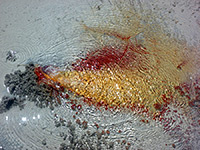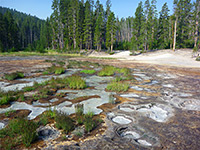Morning Mist Springs and the Quagmire Group, Yellowstone National Park
Wyoming > Yellowstone National Park > The Southwest > Hiking > Morning Mist Springs
Morning Mist Springs and the Quagmire Group
Loop hike, partly off trail, to two backcountry thermal areas of the Lower Geyser Basin; a group of small pools in open grassland near Nez Perce Creek, and a more secluded collection of larger springs, beneath a wooded hillside
Length: 2.5 miles, round trip
Elevation change: 250 feet
Difficulty: Easy
Type: Loop - along the Mary Mountain Trail to the springs, cross country to the Quagmire Group
Usage: Low
Season: Summer, fall
Trailhead: Pullout on the east side of the highway, at the edge of Fountain Flats
Rating (1-5): ★★★★★
Elevation change: 250 feet
Difficulty: Easy
Type: Loop - along the Mary Mountain Trail to the springs, cross country to the Quagmire Group
Usage: Low
Season: Summer, fall
Trailhead: Pullout on the east side of the highway, at the edge of Fountain Flats
Rating (1-5): ★★★★★
Yellowstone's Lower Geyser Basin contains over 1,500 thermal features, more than any other area of the park, and while many are either beside the road hence viewable from overlooks and boardwalks, or are unreachable owing to unstable surroundings, there are still plenty of opportunities for visiting backcountry springs and pools, along paths or by careful off-trail hiking.
Notable regions include Sentinel Meadows, the River Group beside the Firehole River, and the Morning Mist Springs, a colorful collection of pretty pools near Nez Perce Creek, accessed by walking one mile down the Mary Mountain Trail, starting along the Grand Loop Road at the north edge of the geyser basin. A short distance south of the path, on the far side of a wooded ridge, is another, more secluded cluster of larger and more active pools known as the Quagmire Group, and a tour through both regions is an interesting short hike, taking a couple of hours or so, and passing more than 50 hot springs.
All visitors need to be familiar with the park regulations concerning off-trail travel in the vicinity of backcountry thermal regions.
Yellowstone National Park trail map, Lower Geyser Basin thermal features map.
15 views of the Morning Mist Springs.
Four thermal features (mp4; 0:33 min; 9 mb).
The Mary Mountain trailhead is on the east side of the highway at the edge of the extensive grasslands of the Fountain Flats - excellent wildlife habitat, with bison usually present and a good chance of seeing other mammals like elk and coyote. The open land continues a little way east, up to the edge of the Porcupine Hills, a line of small, conical summits, beyond which the terrain becomes predominantly wooded. The path heads due east between two of the hills then follows Nez Perce Creek for ten miles up to the Central Plateau, descending the far side into Hayden Valley.
The plateau has a few small vents and springs but many more are found at the start of the trail, between 0.4 and 0.9 miles from the highway; the first are just north of the path at the foot of the hills, and include the only named feature in the area (Porcupine Hills Geyser), a deep, constantly bubbling pool of clear water. Other nearby pools are less vigorous, lined by algae of varying colors, and extend round the hill to the northwest. The Morning Mist Springs are reached a short distance further along the path, again on the north side - several dozen delicate, compact, circular vents sustaining shallow pools of different temperatures and colors, ranging from warm brown/red to hot clear/blue. None are actively bubbling but the springs are still photogenic, producing wavy run-off channels that are also quite colorful.
After passing through a belt of woodland on the east side of the Morning Mist Springs, the Mary Mountain Trail skirts another thermal area named Culex Basin, but features here are generally small and uninteresting. Better are the pools of the Quagmire Group, reachable by walking south from the springs, over a wooded saddle between two of the Porcupine Hills and down the far side, to the west end of an arc of treeless ground beneath the rocky, south face of the hills in which are found several noisy, sulphurous vents.
The band of hot springs stretches for 0.4 miles and some of the pools are very deep, including one filled with beautiful, clear blue water surrounded by an orange-yellow algae ring, like the famous Morning Glory Pool in the Upper Geyser Basin. Others are quite active, and enough water is produced to form wide, marshy run-off channels and algae-covered depositional terraces, making cross-country walking rather difficult in some places. After viewing the springs, the return route is west through the forest for a quarter of a mile, emerging at the edge of the Fountain Flats close to the Mary Mountain trailhead.
Notable regions include Sentinel Meadows, the River Group beside the Firehole River, and the Morning Mist Springs, a colorful collection of pretty pools near Nez Perce Creek, accessed by walking one mile down the Mary Mountain Trail, starting along the Grand Loop Road at the north edge of the geyser basin. A short distance south of the path, on the far side of a wooded ridge, is another, more secluded cluster of larger and more active pools known as the Quagmire Group, and a tour through both regions is an interesting short hike, taking a couple of hours or so, and passing more than 50 hot springs.
All visitors need to be familiar with the park regulations concerning off-trail travel in the vicinity of backcountry thermal regions.
Maps
Yellowstone National Park trail map, Lower Geyser Basin thermal features map.
Photographs
15 views of the Morning Mist Springs.
Video of the Morning Mist Springs
Four thermal features (mp4; 0:33 min; 9 mb).
Morning Mist Springs
The Mary Mountain trailhead is on the east side of the highway at the edge of the extensive grasslands of the Fountain Flats - excellent wildlife habitat, with bison usually present and a good chance of seeing other mammals like elk and coyote. The open land continues a little way east, up to the edge of the Porcupine Hills, a line of small, conical summits, beyond which the terrain becomes predominantly wooded. The path heads due east between two of the hills then follows Nez Perce Creek for ten miles up to the Central Plateau, descending the far side into Hayden Valley.
Porcupine Hills Geyser
The plateau has a few small vents and springs but many more are found at the start of the trail, between 0.4 and 0.9 miles from the highway; the first are just north of the path at the foot of the hills, and include the only named feature in the area (Porcupine Hills Geyser), a deep, constantly bubbling pool of clear water. Other nearby pools are less vigorous, lined by algae of varying colors, and extend round the hill to the northwest. The Morning Mist Springs are reached a short distance further along the path, again on the north side - several dozen delicate, compact, circular vents sustaining shallow pools of different temperatures and colors, ranging from warm brown/red to hot clear/blue. None are actively bubbling but the springs are still photogenic, producing wavy run-off channels that are also quite colorful.
Quagmire Group
After passing through a belt of woodland on the east side of the Morning Mist Springs, the Mary Mountain Trail skirts another thermal area named Culex Basin, but features here are generally small and uninteresting. Better are the pools of the Quagmire Group, reachable by walking south from the springs, over a wooded saddle between two of the Porcupine Hills and down the far side, to the west end of an arc of treeless ground beneath the rocky, south face of the hills in which are found several noisy, sulphurous vents.
Pools and Springs
The band of hot springs stretches for 0.4 miles and some of the pools are very deep, including one filled with beautiful, clear blue water surrounded by an orange-yellow algae ring, like the famous Morning Glory Pool in the Upper Geyser Basin. Others are quite active, and enough water is produced to form wide, marshy run-off channels and algae-covered depositional terraces, making cross-country walking rather difficult in some places. After viewing the springs, the return route is west through the forest for a quarter of a mile, emerging at the edge of the Fountain Flats close to the Mary Mountain trailhead.
Morning Mist Springs - Similar Hikes
All Contents © Copyright The American Southwest | Comments and Questions | Contribute | Affiliate Marketing Disclosure | Site Map













